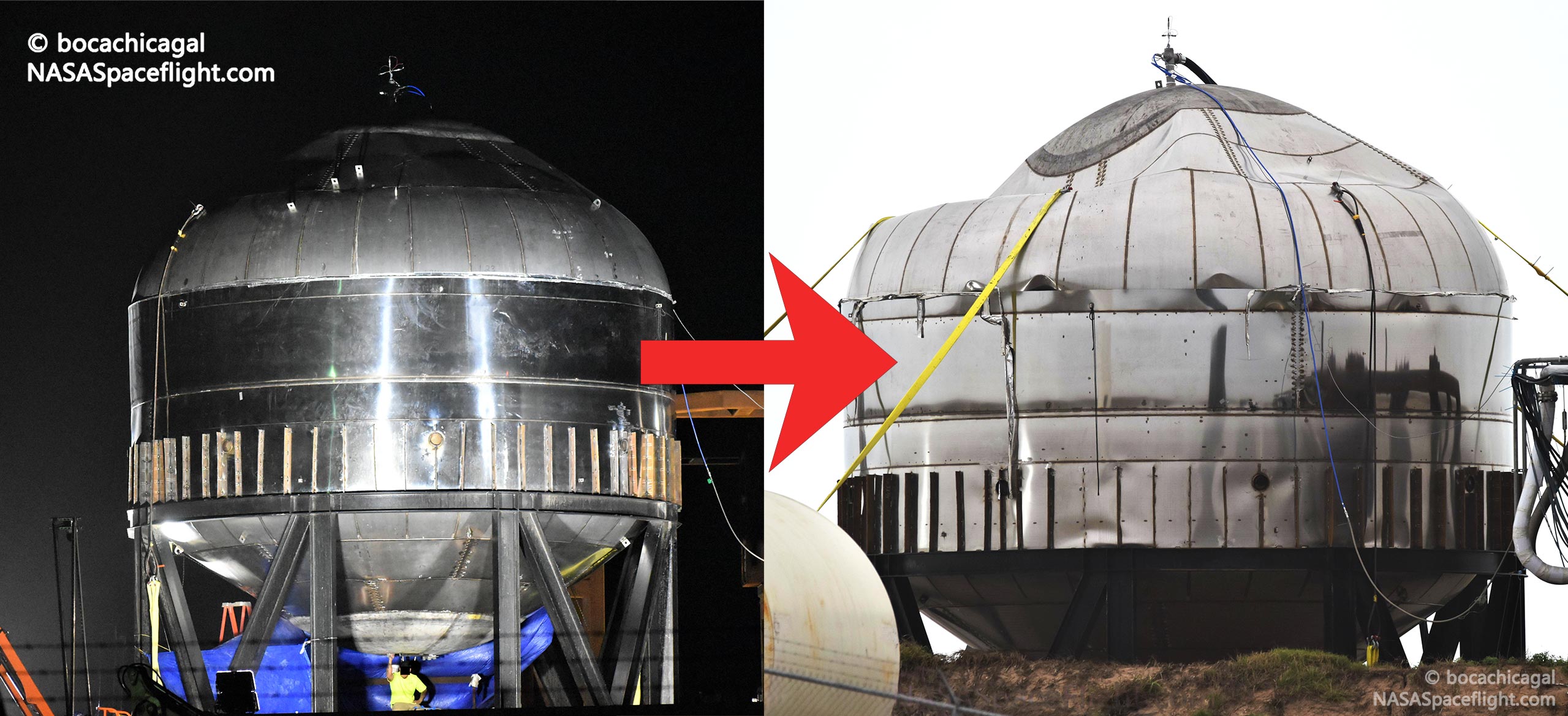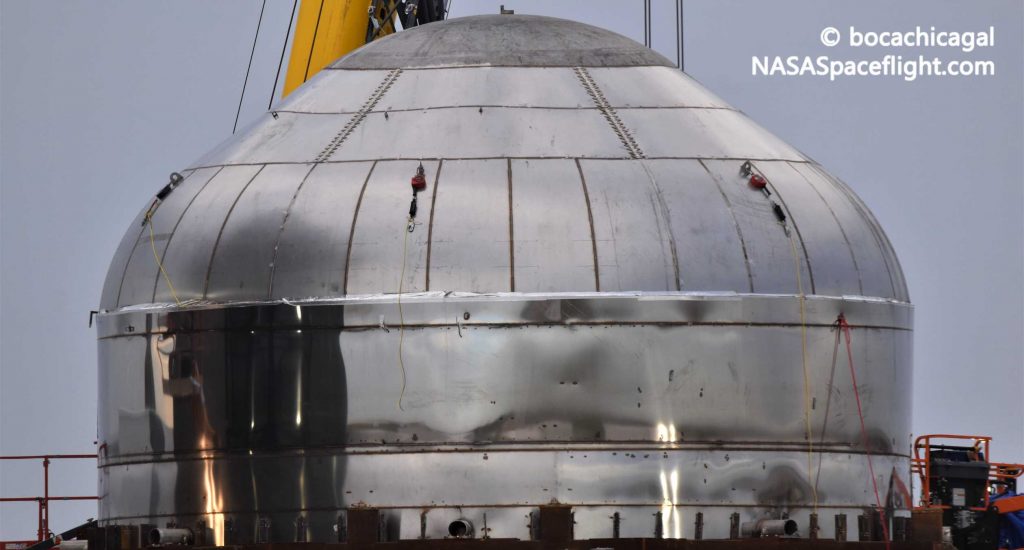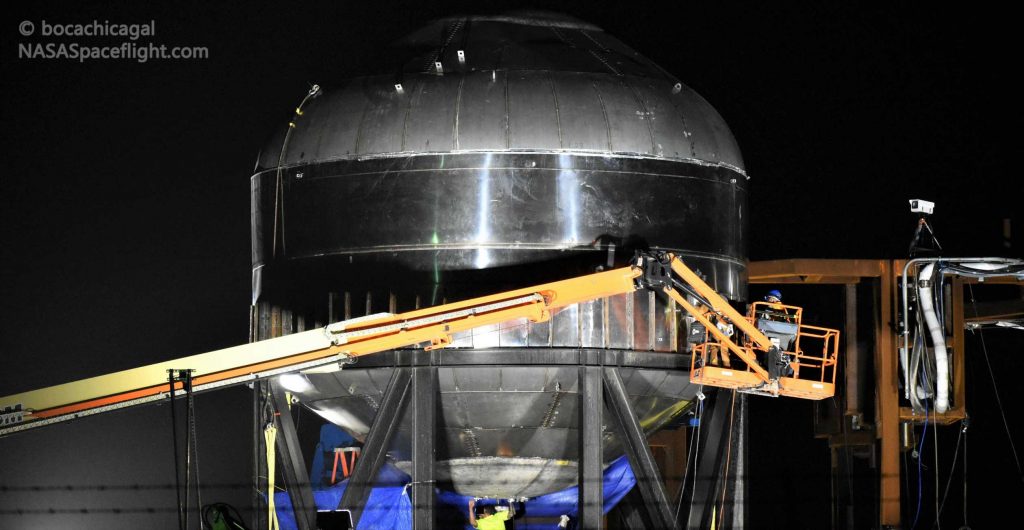

News
SpaceX just blew up a Starship tank on purpose and Elon Musk says the results are in
Before dawn on January 10th, SpaceX technicians and engineers intentionally blew up a miniature Starship tank in order to test recently-upgraded manufacturing and assembly methods, likely to be used to build the first Starships bound for flight tests and orbit.
SpaceX CEO Elon Musk quickly weighed in on Twitter later the same day, revealing some crucial details about the Starship tank test and effectively confirming that it was a success. While somewhat unintuitive, this is the second time SpaceX has intentionally destroyed largely completed Starship hardware in order to determine the limits of the company’s current methods of production and assembly.
Most notably, on November 20th, SpaceX is believed to have intentionally overpressurized the Starship Mk1 prototype in a very similar – albeit larger-scale – test, destroying the vehicle and sending its top tank dome flying hundreds of feet into the air. It’s generally believed that SpaceX (or perhaps even just Musk) decided that Starship Mk1 was not fit to fly, leading the company to switch gears and deem the prototype a “manufacturing pathfinder” rather than the first Starship to fly – which Musk had explicitly stated just a few months prior.
Bopper (Baby StarPopper) this morning after the overpressure event at SpaceX Boca Chica. ??@NASASpaceflight https://t.co/nCG7E9XtKM pic.twitter.com/PRTDQvvlRh— Mary (@BocaChicaGal) January 10, 2020
Dome to barrel weld made it to 7.1 bar, which is pretty good as ~6 bar is needed for orbital flight. With more precise parts & better welding conditions, we should reach ~8.5 bar, which is the 1.4 factor of safety needed for crewed flight.— Buff Mage (@elonmusk) January 10, 2020
Instead, Starship Mk1 suffered irreparable damage during its pressurization test and was rapidly scrapped in the weeks following, although several segments were thankfully salvaged – perhaps for use on future prototypes. Along those lines, it can arguably be said that the results from the mini Starship tank’s Jan. 10 pop test have paved the way for SpaceX to build the first truly flightworthy Starship prototypes – potentially all the way up to the first spaceworthy vehicles.
Hours after the test, Musk revealed that the Starship test tank failed almost exactly where and how SpaceX expected it would, bursting when the weld joining the upper dome and tank wall failed. Critically, the tank reached a maximum sustained pressure of 7.1 bar (103 psi), some 18% over the operating pressure (6 bar/87 psi) Musk says Starship prototypes will need to be declared fully capable of orbital test flights. In other words, given the tank’s size, it survived an incredible ~20,000 metric tons (45 million lbf) of force spread out over its surface area, equivalent to about 20% the weight of an entire US Navy aircraft carrier.
Musk also revealed that SpaceX will require Starships to survive a minimum of 140% of that operating pressure before the company will allow the spacecraft to launch humans.
Some have less than generously taken to smugly noting that several modern spaceflight and engineering standards require that launch vehicle tankage be rated to survive no less than 125% of their operating pressure, while this test tank would be rated for less than 118% under identical conditions. However, this ignores several significant points of interest. First and foremost, the Starship test tank intentionally destroyed on January 10th was assembled from almost nothing – going from first weld to a completed pressurization test – in less than three weeks (20 days).
Second, all visible welding and assembly work was performed outside in the South Texas elements with only a minor degree of protection from the coastal winds and environment. Although some obvious tweaks were made to the specific methods used to assembly the prototype tank, it also appears that most of the welding was done by hand. For the most part, in other words, the methods used to build this improved test article were largely unchanged compared to Starship Mk1, which is believed to have failed around 3-5 bar (40-75 psi).
Additionally, it appears that almost all aspects of this test tank have smaller structural margins, meaning that the tank walls and domes are likely using steel stock that is substantially thinner than what was used on Starship Mk1. Nevertheless, thanks to the addition of continuous (single-weld) steel rings, a tweaked dome layout, and slightly refined welding, this test tank has performed anywhere from 20% to 200+% better than Starship Mk1 – again, all while coming together from scratch in a period of less than three weeks.

As Musk notes, with relatively minor improvements to welding conditions and the manufacturing precision of Starship rings and domes, SpaceX can likely ensure that Starships (and thus Super Heavy boosters) will be able to survive pressures greater than 8.5 bar (125 psi), thus guaranteeing a safety margin of at least 40%. Even a minor improvement of ~6% would give vehicles a safety margin of 125%, enough – in the eyes of engineering standards committees – to reasonably certify Starships for orbital test flights.


All things considered, it’s safe to assume that SpaceX is going to begin building and assembling Starship SN01 (formerly Mk3) hardware almost immediately. Given that this test tank took just 20 days to assemble, it’s safe to say that the upgraded prototype’s tank section could be completed in just a handful of weeks. Stay tuned for progress reports.
Check out Teslarati’s Marketplace! We offer Tesla accessories, including for the Tesla Cybertruck and Tesla Model 3.

Elon Musk
Elon Musk and Tesla AI Director share insights after empty driver seat Robotaxi rides
The executives’ unoccupied tests hint at the rapid progress of Tesla’s unsupervised Robotaxi efforts.

Tesla CEO Elon Musk and AI Director Ashok Elluswamy celebrated Christmas Eve by sharing personal experiences with Robotaxi vehicles that had no safety monitor or occupant in the driver’s seat. Musk described the system’s “perfect driving” around Austin, while Elluswamy posted video from the back seat, calling it “an amazing experience.”
The executives’ unoccupied tests hint at the rapid progress of Tesla’s unsupervised Robotaxi efforts.
Elon and Ashok’s firsthand Robotaxi insights
Prior to Musk and the Tesla AI Director’s posts, sightings of unmanned Teslas navigating public roads were widely shared on social media. One such vehicle was spotted in Austin, Texas, which Elon Musk acknowleged by stating that “Testing is underway with no occupants in the car.”
Based on his Christmas Eve post, Musk seemed to have tested an unmanned Tesla himself. “A Tesla with no safety monitor in the car and me sitting in the passenger seat took me all around Austin on Sunday with perfect driving,” Musk wrote in his post.
Elluswamy responded with a 2-minute video showing himself in the rear of an unmanned Tesla. The video featured the vehicle’s empty front seats, as well as its smooth handling through real-world traffic. He captioned his video with the words, “It’s an amazing experience!”
Towards Unsupervised operations
During an xAI Hackathon earlier this month, Elon Musk mentioned that Tesla owed be removing Safety Monitors from its Robotaxis in Austin in just three weeks. “Unsupervised is pretty much solved at this point. So there will be Tesla Robotaxis operating in Austin with no one in them. Not even anyone in the passenger seat in about three weeks,” he said. Musk echoed similar estimates at the 2025 Annual Shareholder Meeting and the Q3 2025 earnings call.
Considering the insights that were posted Musk and Elluswamy, it does appear that Tesla is working hard towards operating its Robotaxis with no safety monitors. This is quite impressive considering that the service was launched just earlier this year.
Elon Musk
Starlink passes 9 million active customers just weeks after hitting 8 million
The milestone highlights the accelerating growth of Starlink, which has now been adding over 20,000 new users per day.

SpaceX’s Starlink satellite internet service has continued its rapid global expansion, surpassing 9 million active customers just weeks after crossing the 8 million mark.
The milestone highlights the accelerating growth of Starlink, which has now been adding over 20,000 new users per day.
9 million customers
In a post on X, SpaceX stated that Starlink now serves over 9 million active users across 155 countries, territories, and markets. The company reached 8 million customers in early November, meaning it added roughly 1 million subscribers in under seven weeks, or about 21,275 new users on average per day.
“Starlink is connecting more than 9M active customers with high-speed internet across 155 countries, territories, and many other markets,” Starlink wrote in a post on its official X account. SpaceX President Gwynne Shotwell also celebrated the milestone on X. “A huge thank you to all of our customers and congrats to the Starlink team for such an incredible product,” she wrote.
That growth rate reflects both rising demand for broadband in underserved regions and Starlink’s expanding satellite constellation, which now includes more than 9,000 low-Earth-orbit satellites designed to deliver high-speed, low-latency internet worldwide.
Starlink’s momentum
Starlink’s momentum has been building up. SpaceX reported 4.6 million Starlink customers in December 2024, followed by 7 million by August 2025, and 8 million customers in November. Independent data also suggests Starlink usage is rising sharply, with Cloudflare reporting that global web traffic from Starlink users more than doubled in 2025, as noted in an Insider report.
Starlink’s momentum is increasingly tied to SpaceX’s broader financial outlook. Elon Musk has said the satellite network is “by far” the company’s largest revenue driver, and reports suggest SpaceX may be positioning itself for an initial public offering as soon as next year, with valuations estimated as high as $1.5 trillion. Musk has also suggested in the past that Starlink could have its own IPO in the future.
News
NVIDIA Director of Robotics: Tesla FSD v14 is the first AI to pass the “Physical Turing Test”
After testing FSD v14, Fan stated that his experience with FSD felt magical at first, but it soon started to feel like a routine.

NVIDIA Director of Robotics Jim Fan has praised Tesla’s Full Self-Driving (Supervised) v14 as the first AI to pass what he described as a “Physical Turing Test.”
After testing FSD v14, Fan stated that his experience with FSD felt magical at first, but it soon started to feel like a routine. And just like smartphones today, removing it now would “actively hurt.”
Jim Fan’s hands-on FSD v14 impressions
Fan, a leading researcher in embodied AI who is currently solving Physical AI at NVIDIA and spearheading the company’s Project GR00T initiative, noted that he actually was late to the Tesla game. He was, however, one of the first to try out FSD v14.
“I was very late to own a Tesla but among the earliest to try out FSD v14. It’s perhaps the first time I experience an AI that passes the Physical Turing Test: after a long day at work, you press a button, lay back, and couldn’t tell if a neural net or a human drove you home,” Fan wrote in a post on X.
Fan added: “Despite knowing exactly how robot learning works, I still find it magical watching the steering wheel turn by itself. First it feels surreal, next it becomes routine. Then, like the smartphone, taking it away actively hurts. This is how humanity gets rewired and glued to god-like technologies.”
The Physical Turing Test
The original Turing Test was conceived by Alan Turing in 1950, and it was aimed at determining if a machine could exhibit behavior that is equivalent to or indistinguishable from a human. By focusing on text-based conversations, the original Turing Test set a high bar for natural language processing and machine learning.
This test has been passed by today’s large language models. However, the capability to converse in a humanlike manner is a completely different challenge from performing real-world problem-solving or physical interactions. Thus, Fan introduced the Physical Turing Test, which challenges AI systems to demonstrate intelligence through physical actions.
Based on Fan’s comments, Tesla has demonstrated these intelligent physical actions with FSD v14. Elon Musk agreed with the NVIDIA executive, stating in a post on X that with FSD v14, “you can sense the sentience maturing.” Musk also praised Tesla AI, calling it the best “real-world AI” today.








